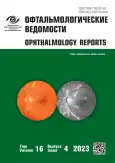The evaluation of cytoxicity of ocular hypotensive therapy to cultured human corneal epithelial cells
- Authors: Fisenko N.V.1, Yusef Y.N.1,2, Subbot A.M.1, Osipyan G.A.1
-
Affiliations:
- M.M. Krasnov Scientific Research Institute of Eye Diseases
- I.M. Sechenov First Moscow State Medical University (Sechenov University)
- Issue: Vol 16, No 4 (2023)
- Pages: 55-66
- Section: Experimental trials
- URL: https://journals.rcsi.science/ov/article/view/254573
- DOI: https://doi.org/10.17816/OV553340
- ID: 254573
Cite item
Abstract
BACKGROUND: Corneal epithelial defect is a corneal epithelial cells’ (CEpC) disruption of various origin. In patients with corneal epithelial defect, glaucoma is a frequent concomitant disease demanding prescription of hypotensive medications, most of which containing benzalkonium chloride.
AIM: The aim of this study is to evaluate cytotoxicity of antiglaucoma drugs, as well as benzalkonium chloride (BAK), to human CEpC in vitro.
MATERIALS AND METHODS: The study was carried out on primary cultures of human CEpC. Cytotoxicity of dorzolamide, brimonidine, timolol (dilutions 1/100, 1/50, 1/20, 1/10, a 24-hour exposure) and of BAK was estimated on the model of intact epithelium (monolayer). Benzalkonium chloride was evaluated in concentrations equals to its concentration in tested ophthalmic solutions. Cytotoxicity of dorzolamide, brimonidine, timolol (dilutions 1/100, 1/20, a 48-hour exposure) was evaluated on the model of corneal epithelial defect (damage of the monolayer). The medication’s cytotoxicity was estimated by cellular changes (phase-contrast microscopy) and by the MTS-test’s results.
RESULTS: Among BAK-free medications: dorzolamide (1/50, 1/20, 1/10 dilutions), brimonidine (1/10 dilution) — induce CEpCs’ pathological changes, whereas timolol (all tested dilutions) is non-toxic. BAK-preserved drugs: dorzolamide, brimonidine, timolol (1/100, 1/50, 1/20, 1/10 dilutions) — induce CEpCs’ damage, their viability reduction, and corneal epithelial defect closure inhibition. BAK shows similar effect in tested concentrations.
CONCLUSIONS: Cytotoxicity of antiglaucoma drugs is attributed to their component — benzalkonium chloride. Administration of preserved drugs is not reasonable in eyes with corneal epithelial defect of various origin.
Full Text
##article.viewOnOriginalSite##About the authors
Natalia V. Fisenko
M.M. Krasnov Scientific Research Institute of Eye Diseases
Email: natfisenko@mail.ru
ORCID iD: 0000-0001-7198-4498
SPIN-code: 9750-1529
MD, Cand. Sci. (Medicine)
Russian Federation, 11 A, B, Rossolimo st., Moscow, 119021Yusef N. Yusef
M.M. Krasnov Scientific Research Institute of Eye Diseases; I.M. Sechenov First Moscow State Medical University (Sechenov University)
Email: info@eyeacademy.ru
ORCID iD: 0000-0003-4043-456X
SPIN-code: 6891-6138
MD, Dr. Sci. (Medicine), Professor
Russian Federation, Moscow; MoscowAnastasia M. Subbot
M.M. Krasnov Scientific Research Institute of Eye Diseases
Email: kletkagb@gmail.com
ORCID iD: 0000-0002-8258-6011
SPIN-code: 3898-2570
MD, Cand. Sci. (Medicine)
Russian Federation, MoscowGrigory A. Osipyan
M.M. Krasnov Scientific Research Institute of Eye Diseases
Author for correspondence.
Email: Gregor79@yandex.ru
ORCID iD: 0000-0002-1056-4331
SPIN-code: 1039-0470
MD, Dr. Sci. (Medicine)
Russian Federation, MoscowReferences
- Sridhar MS. Anatomy of cornea and ocular surface. Indian J Ophthalmol. 2018;66(2):190–194. doi: 10.4103/ijo.IJO_646_17
- Dahlgren MA. Persistent epithelial defects. In: Albert DM, Miller JW, editors. Albert and Jakobiec’s principles and practice of ophthalmology. Philadelphia: Elsevier, 2008. P. 749–759.
- Vaidyanathan U, Hopping GC, Liu HY, et al. Persistent corneal epithelial defects: a review article. Med Hypothesis Discov Innov Ophthalmol. 2019;8(3):163–176.
- European Glaucoma Society terminology and guidelines for glaucoma, 5th edition. Br J Ophthalmol. 2021;105(S1):1–169. doi: 10.1136/bjophthalmol-2021-egsguidelines
- Steven DW, Alaghband P, Lim KS. Preservatives in glaucoma medication. Br J Ophthalmol. 2018;102(11):1497–1503. doi: 10.1136/bjophthalmol-2017-311544
- Goldstein MH, Silva FQ, Blender N, et al. Ocular benzalkonium chloride exposure: problems and solutions. Eye (Lond). 2022;36(2):361–368. doi: 10.1038/s41433-021-01668-x
- Thacker M, Sahoo A, Reddy AA, et al. Benzalkonium chloride-induced dry eye disease animal models: Current understanding and potential for translational research. Indian J Ophthalmol. 2023;71(4):1256–1262. doi: 10.4103/IJO.IJO_2791_22
- Ayaki M, Yaguchi S, Iwasawa A, Koide R. Cytotoxicity of ophthalmic solutions with and without preservatives to human corneal endothelial cells, epithelial cells and conjunctival epithelial cells. Clin Exp Ophthalmol. 2008;36(6):553–559. doi: 10.1111/j.1442-9071.2008.01803.x
- Fisenko NV, Subbot AM, Fisenko VP. Evaluation of the cytotoxicity of antiglaucoma drugs and auxiliary components against primary culture of human corneal endothelial cells. Experimental and Clinical Pharmacology. 2022;85(8):26–33. (In Russ.) doi: 10.30906/0869-2092-2022-85-8-26-33
- Agrahari V, Mandal A, Agrahari V, et al. A comprehensive insight on ocular pharmacokinetics. Drug Deliv Transl Res. 2016;6(6): 735–754. doi: 10.1007/s13346-016-0339-2
- Durairaj C. Ocular Pharmacokinetics. In: Whitcup S, Azar D, editors. Pharmacologic therapy of ocular disease. Handbook of experimental pharmacology. Vol. 242. Springer, Cham, 2017. P. 31–55. doi: 10.1007/164_2016_32
- Abysheva LD, Avdeev RV, Alexandrov AS, et al. Influence of local hypotensive glaucoma therapy on the development and progression of dry eye syndrome. RMJ. Clinical ophthalmology. 2017;17(2):74–82. (In Russ.) doi: 10.21689/2311-7729-2017-17-2-74-82
- Andole S, Senthil S. Ocular surface disease and anti-glaucoma medications: various features, diagnosis, and management guidelines. Semin Ophthalmol. 2023;38(2):158–166. doi: 10.1080/08820538.2022.2094714
- Pozarowska D, Pozarowski P, Darzynkiewicz Z. Cytometric assessment of cytostatic and cytotoxic effects of topical glaucoma medications on human epithelial corneal line cells. Cytometry B Clin Cytom. 2010;78B(2):130–137. doi: 10.1002/cyto.b.20493
- Ammar DA, Noecker RJ, Kahook MY. Effects of benzalkonium chloride-preserved, polyquad-preserved, and sofZia-preserved topical glaucoma medications on human ocular epithelial cells. Adv Ther. 2010;27(11):837–845. doi: 10.1007/s12325-010-0070-1
- Epstein SP, Ahdoot M, Marcus E, Asbell PA. Comparative toxicity of preservatives on immortalized corneal and conjunctival epithelial cells. J Ocul Pharmacol Ther. 2009;25(2):113–119. doi: 10.1089/jop.2008.0098
- Meloni M, Cattaneo G, De Servi B. Corneal epithelial toxicity of antiglaucoma formulations: in vitro study of repeated applications. Clin Ophthalmol. 2012;6:1433–1440. doi: 10.2147/OPTH.S35057
- Kucukoduk A, Durmus IM, Aksoy M, Karakurt S. Cytotoxic, apoptotic, and oxidative effects of preserved and preservative-free brimonidine in a corneal epithelial cell line. J Ocul Pharmacol Ther. 2022;38(8):576–583. doi: 10.1089/jop.2022.0053
- Liang H, Baudouin C, Daull P, et al. In vitro corneal and conjunctival wound-healing assays as a tool for antiglaucoma prostaglandin formulation characterization. Front Biosci (Landmark Ed). 2022;27(5):147. doi: 10.31083/j.fbl2705147
Supplementary files











